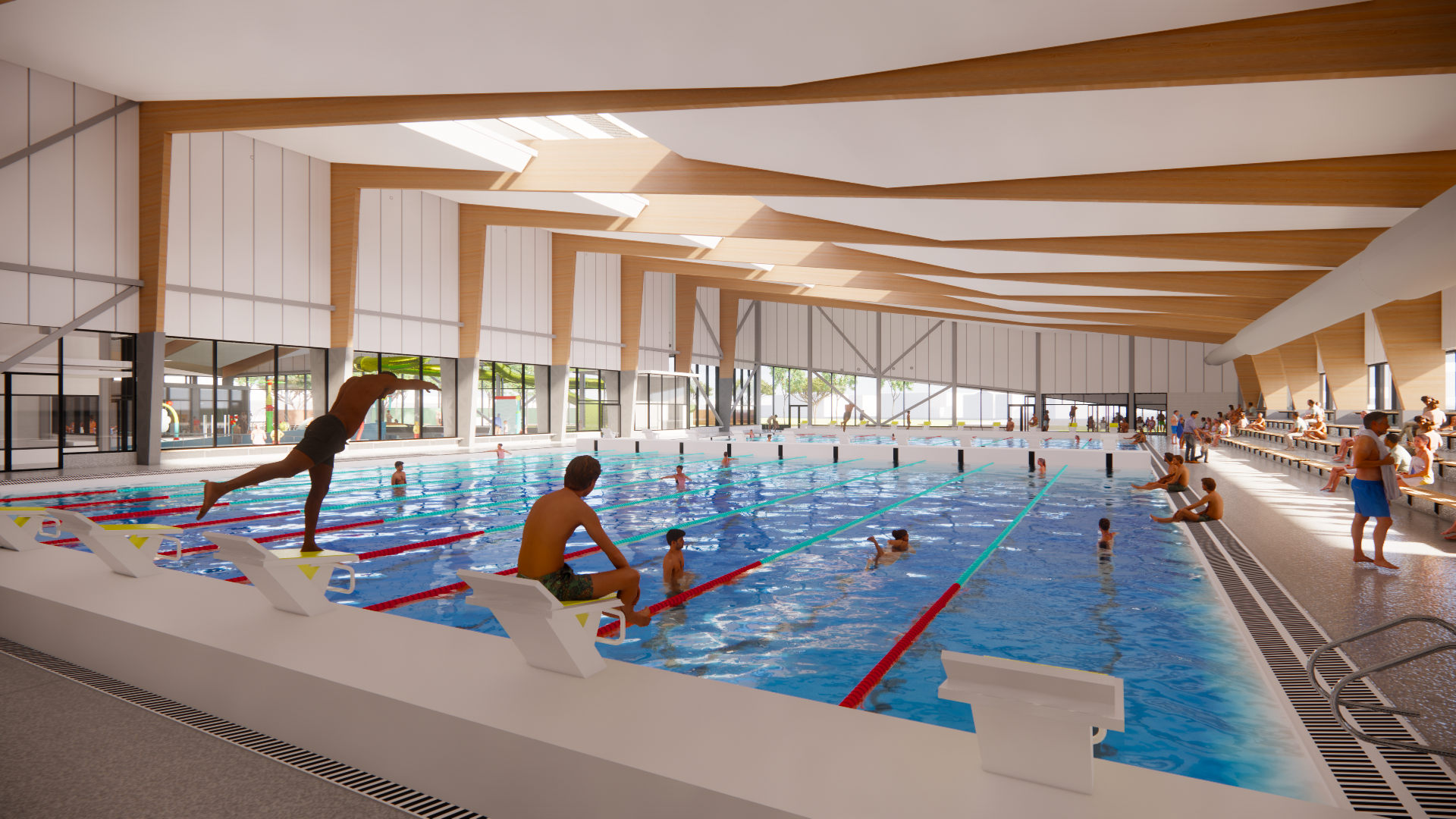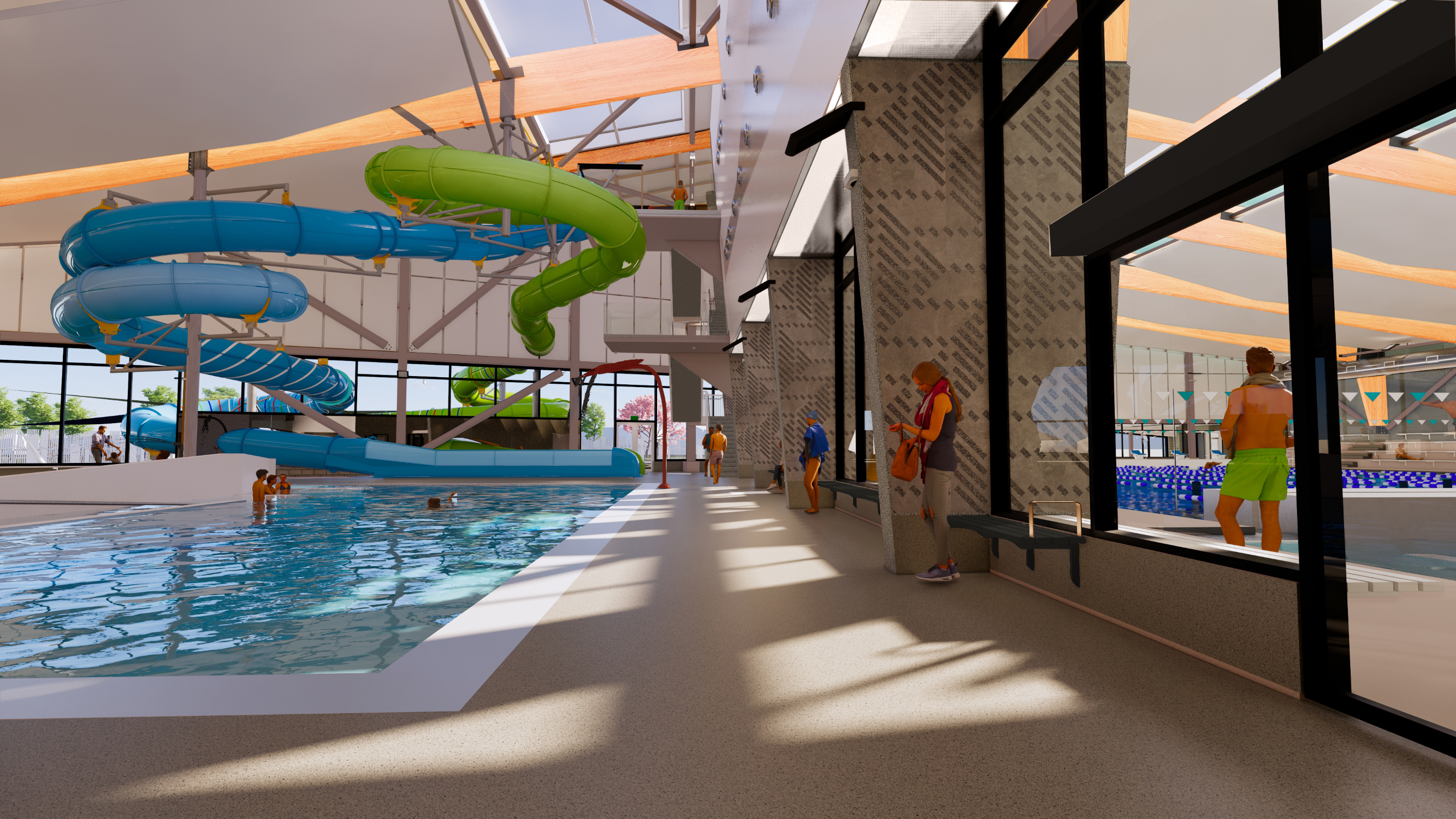Becoming Aotearoa’s first Green Star Five rated aquatic centre
Sustainability is a key tenet of the design and build of the new Naenae Pool and Fitness Centre. The old pool ran on natural gas and was a major contributor to greenhouse gas emissions.
The new pool will reduce emissions by nearly 50%, and will be the first Green Star Five rated aquatic centre in the country- but what does that really mean?
We spoke to Chris Mills of engineering firm Powell Fenwick to learn more about the sustainability of the pool and our Green Star certification. Chris is the Project Green Star Accredited Professional and has been involved in the project since the early design phases.
Powell Fenwick has a team of four Green Star Accredited Professionals who play an active role in the sustainable design of several building projects across New Zealand.

What is Green Star?
Green Star is a building project rating and certification tool. There are two certification types: you have a Design rating which is completed based on design documentation and commitments before the building is constructed, and then a final As Built rating which is based on the finished project and the final documentation once the building is complete. The Design rating is a very detailed check that the project team are incorporating all the right things during design, while the As Built rating certification stays with the building for its entire lifetime.
How does it work?
Green Star uses nine categories of sustainability, and within each of those are credits. Each credit has a points value based on the perceived sustainable value of each of each item. Projects accumulate points based on the project requirements and, based on the number of points that you achieve, you get a star rating between four and six stars.
The categories include the management of the building project and its operation, the indoor environment quality – including lighting, fresh air, acoustics, and temperature. There's energy use, water usage and sustainable transport. For this building in particular, energy and water efficiency are a major focus as aquatic facilities use a large amount of energy and water.
Another category looks at the materials selected to build the building, making sure they are environmentally sourced and healthy for the builders and occupants. There's land use and ecology of the site, and emissions from the site during operation. The ninth category is innovation, which rewards projects for doing exciting and innovative things, either with cutting edge technology, incorporating fascinating design features or considering practices often overlooked in regular projects.
A four-star rating requires at least 45 points, five-stars requires at least 60 points, and the top six-star rating required at least 75 points. The Naenae project is targeting a five-star rating, so we’re targeting more than 60 points to get there. A five-star rating corresponds to a project demonstrating New Zealand Excellence.

The new pool will have high indoor air quality, high standards of acoustic, lighting, visual and thermal comfort and energy efficient pool services.
What does your role involve?
Part of my role as the Green Star Accredited Professional is to work with the design team & contractor to highlight what they need to provide in their specifications and design drawings as evidence.
We will generally sit down with the client and the lead architect early on to discuss what really matters to them, because there are a lot of credits and points to choose from. Getting the client, design and construction teams aligned to what really matters early-on in the design stage makes a Green Star project run smoothly.
After this initial meeting, we will put together a credit points tracker, which is a document we use to track the required project submission information. Once that’s done, we would run a few workshops with the high-level project design team and then the wider detailed engineering team to make sure that everything that the Green Star professional has put into the tracker is achievable for this project. From there we play an advisory and liaison role until it comes to submission time, helping to interpret the Green Star Submission Guidelines for the project team members.
We do the same throughout the construction phase, providing guidance and advice to the contractor and their subcontractors so that everything is on track for the final As Built rating assessment.
How do you get the rating?
Once the design is complete, we compile all the evidence into a submission and send it to the New Zealand Green Building Council (NZGBC) for audit. The submission evidence is independently verified via an intensive process, usually involving two Green Star Assessors, who will go through every credit with fine-tooth comb.
If we have given enough evidence in the first-round submission, we receive our Green Star Design rating, and the project is officially certified. If not, we will go back for the additional information and resubmit a second time. A Design rating expires two years after the Practical Completion of a project, so an As Built rating is required.
We follow the same process for the As Built rating but use the actual as-built information. Once the NZGBC is satisfied with the evidence, the building receives its As Built certification which stays with the building for its entire lifetime.
The best way for a Green Star project to achieve its goals is to have a really committed client with a clear vision, a design team who is fully on-board, and a really good construction main contractor to drive things on site and show strong sustainable leadership to the subcontractors.

The building will have centralised heating, cooling and electrical systems, and meter and monitor energy and water use.
What are the benefits of getting a Green Star rating?
For me, the benefit to a Green Star certification is that it is independently verified. It's like me, I'm a mechanical engineer, I went to university, and I got a piece of paper that says I’m qualified. I could have done the same thing and just not got the actual degree, but would you trust me as a mechanical engineer based on my word alone? Probably not.
The other key feature is that the Green Star process takes a holistic y approach to sustainability. A lot of projects focus on specific sustainability initiatives, like energy, but Green Star looks at all the major aspects of sustainability, under the nine categories, to get a more balanced outcome for building owners and users alike.
Why does it matter?
Reducing energy use, improving thermal efficiency, and reducing water usage helps to take a lot of demand off the various infrastructure that are already in place, and reduces actual operating costs.
There are numerous studies linking high quality indoor environments to improved health benefits of occupants, which aligns with the Naenae Pool and Fitness Centre’s goals for the community.
I think local and national government leading the charge is important. The project team has put a lot of effort into reducing the impact of an energy-intensive facility like a pool while producing a space that's nice and healthy to be in for the users
A Green Star rating shows that Council cares about the people who are coming to use this building because they want to build something that's good for the environment and good for the users. It's not just walls and a roof with some water in some pool tanks - it will be a really special place for the whole community to enjoy.
To read more about the sustainable features of the new pool, head to our Naenae Projects page.